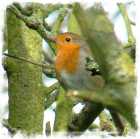

|
|
Nature > Birds > The robin |
|
Web links to more information at the foot of the page |
|  Photo by Richard Dunn |
|
DECEMBER - THE ROBIN The robin and Christmas:
The robin, not the turkey, is the real Christmas bird; you will find his unmistakable red breast featured on cards, cakes and Christmas trees. The robin has become one of the great icons of Christmas. It was his red breast that helped him gain this symbolic Christmas role. In Victorian times, postmen wore a red uniform and were known as "Robin redbreasts". They were servants of the Crown, and in those days there were postal deliveries even on Christmas Day. So the robin became associated with the postman and the gifts which he brought. The robin has another Christian association. Folklore has it that a robin landed on the shoulder of Jesus as He carried the cross. When the bird plucked thorns from His brow, the bird’s breast was stained forever with Christ's blood. Thus the robin gained religious significance. Identification: The robin is one of our most common birds. Results from the British Trust for Ornithology’s Garden Bird Feeding Survey, published this Autumn, reveal that every garden in the survey had a robin! Feed the birds!: Birdtables can make a big difference to the survival of urban and suburban robins. The favourite birdtable treat is mealworms. Other useful foods are meaty kitchen scraps, fat, cheese, cake and biscuit crumbs, and dried fruit. Peanuts are also taken, but they are better shredded or crushed than whole. Robins are resident in Britain throughout the year, in towns and cities as well as the country, and very rarely move far from home. Many Scandinavian and German robins migrate to winter here. They are found throughout Europe including European Russia, and breed also in northern Morocco, Algeria, the Canary Islands and Madeira. Behaviour:
Robins are ground feeders. They eat mostly insects and earthworms. Great opportunists, they will approach a gardener to cash in on the earth worms and insect larvae turned up by the spade. They can become extremely tame by repeated offers of food, and some will even feed from the hand. Being resourceful, robins visit our gardens in winter when natural foods are hard to find during the short cold days. They have learned that people give "hand-outs", or is it presents, particularly at Christmas time. This tameness seems a characteristic of British robins, since elsewhere in their range they are shy woodland birds. In late winter or early spring, male robins take up territories. The territory is an area, perhaps an acre in extent, which the robin defends against all other robins. He declares his ownership by singing from perches on the edge of the territory. The song consists of a cadence followed by a short silence during which the bird listens for 'replies' from neighbours and potential rivals. If a rival intrudes, the territory owner will sing loudly and fly towards the challenger. He will puff out and display his red breast and ritually threaten the rival. If that fails he will resort to fighting. This can result in serious injury or death and is used only as a last resort. The function of song and the red breast, then, is as a deterrent, to avoid “going to war” wherever possible. The territorial system is very strong in robin society. They are very anti-social birds. A stuffed specimen placed in a territory will be torn to pieces by the owner. It has been said that the only place you are likely to find more than a pair of robins together is on a Christmas card! This fiercely territorial nature led one orthnithologist to opine that, “a more inappropriate symbol of the season of peace and goodwill would be hard to find”. The song has a second function. It attracts females! The robin is closely related to the nightingale, and its song is delightful and musical, flute-like and pitched higher than that of a blackbird. Being territorial all year-round means that the song can be heard throughout the winter months, and robins can often be heard singing at night throughout the year, often prompted by street lighting. Unusually, female robins can also sing. Breeding:
Robins usually nest in a hollow in a wall or bank, but sometimes on the ground. They are famous for nesting in all kinds of unlikely locations, including sheds, kettles, boots, hanging baskets, coat pockets, under car bonnets, in farm machinery, even on boats in daily use. They will use open-fronted nest boxes, best placed in a hidden location in a climber or other such vegetation. There are usually two clutches of four to six eggs. Occasionally a third clutch is laid. The female incubates and is fed on the nest by the male. A new nest is built for the second clutch but occasionally the old nest is reused. Building a new nest helps to reduce the numbers of ticks and lice which proliferate during early summer. Both parents feed the young. The fledglings become independent about three weeks after leaving the nest. At the end of breeding season, both parents are exhausted. It is imperative that they grow new feathers, as without them the birds are vulnerable to predators. They become shy and skulking at this time. The territorial system and the pair bonds break down. As winter approaches both males and females, now with their new
feathers, establish individual territories. These are smaller than
the spring territories of the male. The song is continued throughout
the winter, but is weaker than in spring. Both males and females
lapse into a sexless state. As winter draws to a close, the cycle
begins once more. The same two birds may pair again but usually
there is a change of mate.
|